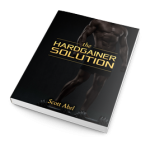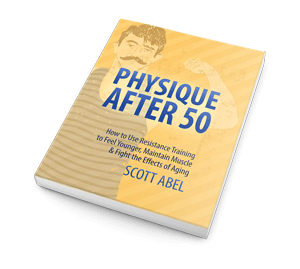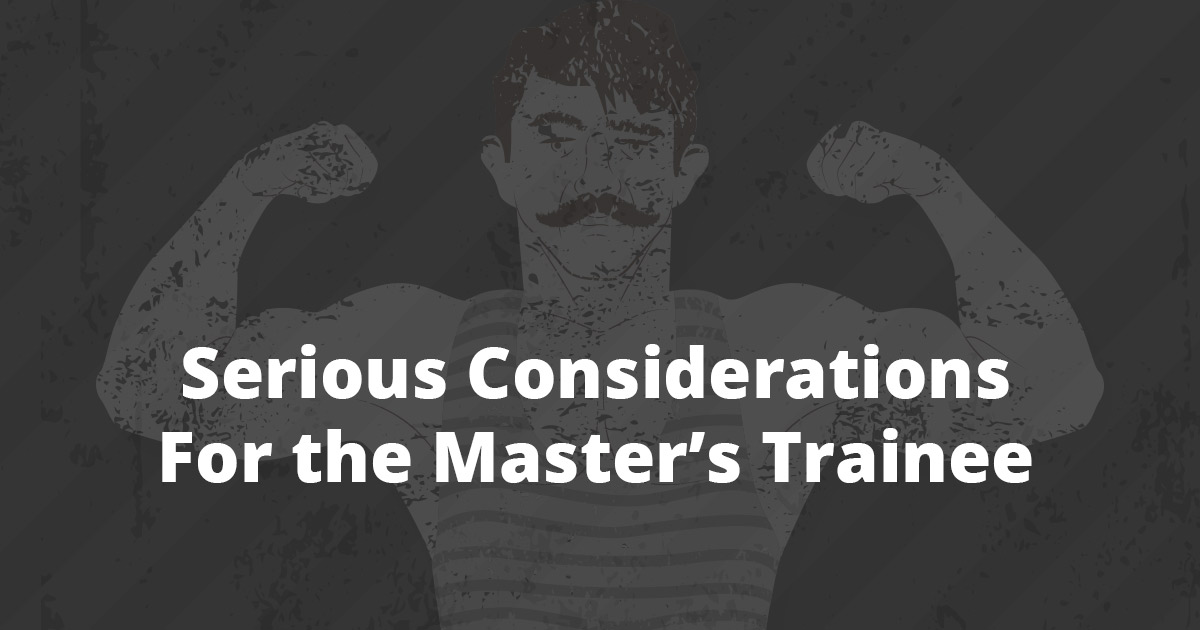I’ll let you all in on a little secret.
I’m old.
Yes, it’s true. And, as the old saying goes, “The older I get, the younger I used to be.”
Things simply change as you age. This is reality. Fighting to maintain “an appearance of youth” seems ridiculous to me. Embracing where I am at in life, and dancing with my years, makes much better sense.
If you are over age 45 (and I am now well over age 45), then there are some realities about training and its effects on your physical body that you need to consider.
Living in ignorance — or worse, trying to live in denial — could get you seriously injured, or make you even more limited as you exercise to stay in shape and be good to yourself.
We aren’t geriatric just yet, but we aren’t 25 years young anymore, either. So, let’s get educated here on certain realities of the aging body, and let's look at some specific considerations for the master’s trainee.
If you pay attention and listen to your body, you can get the most out of your training regimen. If you are a trainer with clients from a few different age brackets, you would do well to learn about the changes in the body as a trainee ages, changes you can’t just “train around,” or “ignore.”
Here we go!
First, as humans advance beyond middle age, some significant changes generally occur:
- sarcopenia (loss of muscle cells)
- increased body fat
- performance loss
- reduced flexibility
…are common effects of aging.
Good news: many of these can combated with regular exercise and a sound diet-strategy of healthy whole foods (and even a Cycle Diet approach!) to optimizing metabolism and keeping it robust.
But reduced flexibility, performance loss, and joint changes are inevitable. These changes should dictate exercise choice moving forward. Let’s talk about some of the facts of aging and how that translates into exercise and training choice for the older trainee.
You trainers out there need to be aware of the fact that many older people (45+) – some of whom may wish to get into shape and/or get strong and gain some muscle – often display bony changes inside the joint capsules, most frequently the shoulders. (I’ll get to that specifically in a moment.)
You also need to know and understand that this situation may not be correctable, no matter how much “corrective exercise” and “muscle balance” nonsense you implement. The intelligent approach would be to work around this reality. Arthritic shoulders (or arthritic hips and knees as well) can be injured badly by overzealous attempts to fix what cannot be fixed. I see this all the time. There are the ridiculous modern exercise “trends” that wreak havoc on older bodies as well.
I still cringe when I hear of people over 45 doing CrossFit when they have virtually no athletic or strength training background. “Certified CrossFit Coaches” talk out of the side of their mouths when saying they can compensate for this in trainees. They clearly don’t understand that the aging physiology eliminates certain exercises from being practical or productive.
More specifically, barbell cleans and snatches may present technical problems in properly racking the bar for older trainees with poor flexibility. Wrists, elbows, shoulders and knees can take an unnecessary amount of abuse when an older trainee is stubbornly trying to master these exercises. All this is before even considering effects on lower lumbar of “sudden impact” of loading in this way. If you combine that with early morning training, as many older trainees like to workout before their day begins, these risks increase. It takes much longer for older joints to open up after a night’s sleep in a horizontal position. To go to a gym and then practice ballistic movements where sudden loading on lower back and on other joints is emphasized, well, this invites more risk than reward in the older trainee.
Trainers need to know this: older trainees in particular may find that that proper shoulder racking of the clean or the lockout position of the snatch is difficult due to a lack of flexibility in the shoulders. Sometimes this can be remedied with stretching and practice, and sometimes it cannot. An example would be a lifter with a history of rotator cuff surgeries, or arthritis issues, as I mentioned above.
For the older “novice” trainee, development of explosive power is not a realistic expectation of any training program or goal. Coupled with the changing quality of the connective tissues comprising the tendons and ligaments in older trainees, the practical result of this aging-related effect on exercise selection is the diminished capacity to productively use real ballistic exercises like the power clean and barbell snatch and explosive pushups, muscle ups etc.: These all increase the likelihood of tendon and joint assault and injury during any explosive or dynamic movements!
 Let me pause and say here that for the older trainee – especially of the more novice type – traditional bodypart training makes the most sense in this age group. Programs like my HardGainer Solution combine elegant reps schemes and exercise selection in a way that won’t inflict more traumas on aging and susceptible joints. It’s one thing to train muscles to combat aging: It’s another thing entirely to have a full-on assault on the joints when doing so. You can do the former without the repercussions of the latter.
Let me pause and say here that for the older trainee – especially of the more novice type – traditional bodypart training makes the most sense in this age group. Programs like my HardGainer Solution combine elegant reps schemes and exercise selection in a way that won’t inflict more traumas on aging and susceptible joints. It’s one thing to train muscles to combat aging: It’s another thing entirely to have a full-on assault on the joints when doing so. You can do the former without the repercussions of the latter.
Furthermore, for the 45-50+ yrs. female trainee who is overweight and completely de-conditioned, it is unlikely that cleans or snatches, kipping chins or muscle-ups will provide enough (or any) value to offset the risk of doing them, or even trying them. Read that sentence over ten times.
In general, it can be assumed that the older the trainee, the less benefit the Olympic lifts with barbells will contribute… and with far more risk at that. I believe it was Rippetoe, an expert on Olympic Lifts and Power Lifts who said this: “And kipping chin ups and muscle-ups and the like should be avoided PERIOD in the older trainee. They just invite too much ballistic trauma in the fragile shoulder joint.”
Again, to my mind, bodypart based programs and my MET methodology make the most sense here. Using bodypart exercises with kinetic chain expression exercises can produce a metabolic “one-two punch” effect, while still considering the joint issues of the older trainee.
Also, for many older novices, particularly those who are also overweight, or who carry most of their weight in their lower body, then full-bodyweight chin-ups and pull-ups are not possible, and working up to them is not a realistic goal; and is in fact a complete waste of gym time. Yet, I still get many trainees who write me and say they have a goal to be able to do so many pull ups or chins: My answer is “why?” – This is just arbitrary. It would be like me saying my goal is to be able to do 3 back handsprings. It wouldn’t “mean” anything if I learned to do them. There would be no added fitness benefit in learning to do them. So we need to get rid of these handed down notions of exercises that supposedly denote fitness or lack of fitness. All exercises are “contextual.” And the context here is the master’s trainee and the realities involved in aging bodies.
Let’s Talk Osteoarthritis
Osteoarthritis is a clinical condition caused by degenerative changes in joints and a loss of joint function. These things come with age. They are not so much “preventable” although they may be delayed. But ironically enough, trainees with years and years of heavy lifting experience behind them are more likely to exacerbate degenerative changes in joints as they age. Many former athletes and lifters can tell you that. I’m one of them. Very often, someone with no lifting background will have less joint issues with age, than someone who was an advanced lifter in their youth. Practically everyone who pushes their physical limits in their younger years, will experience repercussions of that in later years.
The problem for people with osteoarthritis is one of counter-intuitive logic. Trainees and/or patients with osteoarthritis typically reduce their activity level to eliminate pain and discomfort, but this actually worsens the condition. Several studies have shown that increasing the strength of the musculature around an affected joint decreases pain and improves function significantly. (As a side note, a number of these studies used squats to reduce knee pain.) I know this was true for me; and I will get to that another time. But it’s the exercise choices that matter here. Keeping the muscles that surround the arthritic joint strong – goes a long way to supporting joint health. So “not training” doesn’t make any sense. But assaulting the joint in training with ballisitic movements makes even less sense. This also means that those of you with arthritic knees or hips should not be doing any form of running at all!
Therefore, the typical strength exercises of the powerlifts and the Olympic Lifts – especially done with barbells and for low reps – these “lifts” need to be reexamined for use in the master trainee’s workout protocol. Once again, here is a good spot for me to reiterate that at this age, traditional bodypart approaches to training make the best sense! And to have a metabolic effect for that kind of training to burn fat and/or optimize metabolism – then the HGS program is a great program for the master trainee that can be done long-term because it always changes. Proper use of reps schemes goes a long way to strengthening muscles around a joint while negating joint assault at the same time.
Other Considerations for Older Trainees
It’s important to understand other realities as well for the “average” master trainee. Older trainees (45-80) tend to be much more sensitive to outside influences on their training, such as a new medication, a bad night’s sleep, a head cold, or missed meals.
Even a hard day of physical labor that is not normally in the daily routine can throw an older trainee’s recovery cycle off significantly, or increase risk of injury or muscle strain. I know many older trainees who decide to pick up some recreational sport like pickup basketball, or ice hockey, and do it “here and there.” They do it infrequently and they feel it! The body simply doesn’t adapt to outside infrequent physical influences as easily as it did before.
But none of this negates the importance of doing exercise and the benefits of strength-density training (bodybuilding training) for the aging trainee. As I said above, there is a mountain of research on the benefits of resistance training (over cardio) as a person gets older. For instance one relevant study showed that training for leg strength was also responsible for improving the ability to walk faster and longer in older people. In one study, twelve weeks of strength training was shown to increase walking endurance by 38%, something walking by itself fails to do! So resistance training still rules over cardio training and especially is better than running or slogging (slow jogging) – the latter of which wreaks havoc on knees and hip alignment for average people of average weight. What is at issue here is the exercises used in resistance training – and training smarter when considering the master trainee.
And it’s not just solely the exercise side of the equation to consider here either. Significant consideration for the master trainee is also to recognize the reduction in the older trainee’s recovery capacity; both within and between harder workouts. Periods of offloading, unloading, and backing off intensity levels should be longer and more frequently practiced than for younger trainees: In other words “programming matters!” And well-timed consecutive days off should be assigned on a regular basis as well if the older trainee is training hard and training consistently – longer breaks of total recovery are essential for improved performance, health and vitality.
On an individual level the biofeedback of the older trainee needs to be that all workouts “feel” doable and not exhausting. An older trainee can train more frequently if he just doesn’t train as hard. And as we age, frequency becomes far more important than intensity – all things considered.
Getting back to lower lumbar area: Outside of joint pain, low back issues and strains, are the most common preventable injury in the older trainee. As strength increases on the major barbell lifts, so does the stress it places on the lower back. For an older trainee especially, chronic inflammation in the lower back or SI joints can become a problem if this kind of exercise stress is not properly managed. Things like back extensions and situps on the decline sit ups bench with shins locked in rollers may do more harm than good for an older lifter with precarious back health – and standing overhead lifts, cleans etc – become especially “risky” – yes, even with good form.
In the upper body musculature, severe lack of mobility in the shoulders is really a very typical problem for weight-training trainees in their 60’s and up- or in their 50’s if they have a past history of lifting heavy weight overhead or any trauma to the shoulder area. And years and years of heavy resistance training can translate into “trauma.” Just ask any osteopath about that.
Shoulder osteoarthritis often prevents a functional lockout position from being reached in movements like shoulder presses and bench presses etc. And if the problem is true bony arthritis, the situation cannot be corrected. If the problems are structural – ‘practicing the lifts’ – ‘corrective exercises’ and ‘stretching’ aren’t going to help, and it may be quite harmful to keep trying. If the ROM reduction is minor, then the best advice is to “do the best you can” – press as much weight as possible within the confines of the joints’ limited mobility, if it doesn’t hurt. I also suggest switching to DB’s only for training and eliminate barbell bench presses altogether. Aging shoulders are often aggravated by barbell bench presses and barbell military presses too; it is not uncommon for these movements to cause major shoulder pain in some trainees, or to irritate preexisting shoulder issues. Remember pain is biofeedback. DB’s aren’t nearly so traumatic to the shoulder joint. And for anyone with advanced shoulder osteoarthritis I can offer you this exercise tip from my own personal experience: Doing simple rotator cuff work at the end of each workout saved me from shoulder replacement surgery – increased my shoulder ROM, and reduced my pain significantly.
Conclusion
Older adults need frequent breaks from very hard training. Older adults do not benefit from high-volume workouts, unless those workouts are bodypart-oriented. Older adults detrain very quickly when intensity is reduced; so this presents a bit of a Catch-22. Loads used during workouts must be progressed very conservatively. Therefore, it is not about lifting heavier, it’s about lifting wiser. Often a variance in reps schemes and exercise angles and backing off intensity and training pace can serve this purpose. Once again, I mention my HGS program here and advise any trainee over 45 to read my 3 part “Base Hit Mindset” articles as well.
There are serious considerations trainees and trainers need to understand and respect when it comes to training the “average” aging workout enthusiast. I know everyone wants to bombard me with the “exceptions” – but exceptions only prove the rule; they don’t change the rule.
As usual, some of you will get it; some of you will not.


